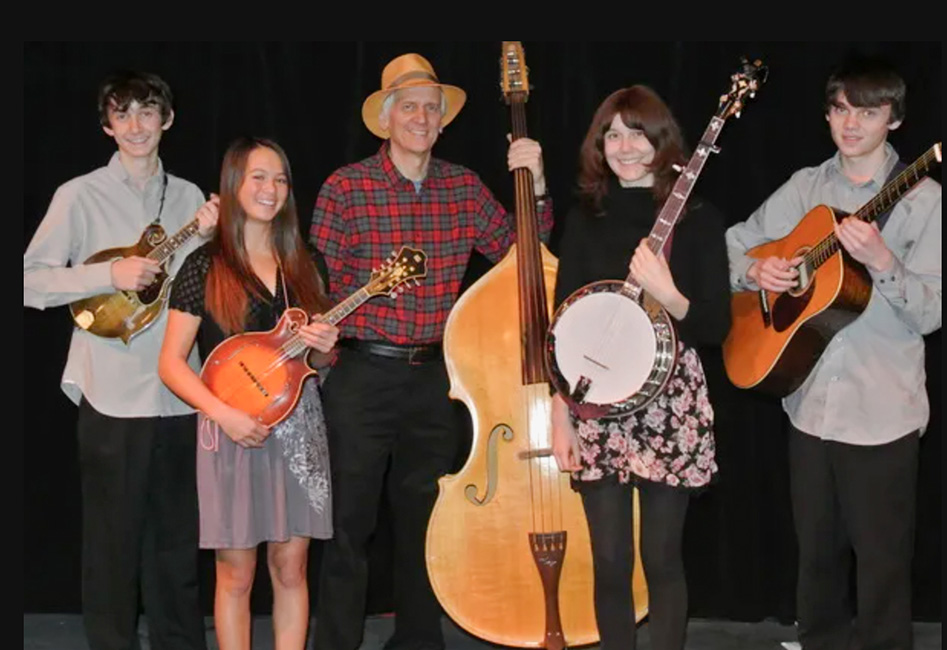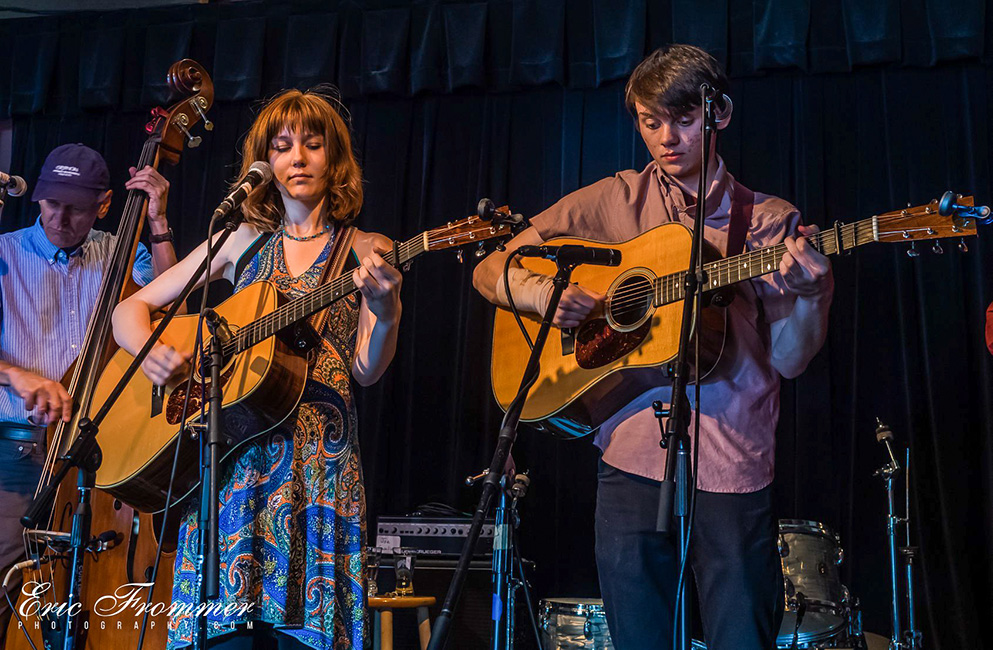
Sully Tuttle at Siesta Valley Strings & Things (7/31/22) – photo © Mary Ann Goldstein
Sullivan (Sully) Tuttle, known for his ferocious guitar playing in the exciting national touring band, AJ Lee and Blue Summit, is a member of the Tuttle family, which is as close as you can get to California bluegrass royalty, at least in Northern California. Sully’s father, fiddler and instructor, Jack Tuttle, is chief enabler in the California Bluegrass Association (CBA) Youth movement that includes Sully and his star sister, Molly Tuttle. Sully, Molly, and AJ Lee played with brother Michael and Jack in one of the original CBA youth bands, The Tuttles with A.J. Lee. Sullivan took some time from his very busy touring schedule with Blue Summit to answer a few questions.
Hi Sullivan. Can you recall your first musical memory?
The first one I can think of is my sister playing and singing Katy Daley with my dad when she was around 8 and I was 6. I started playing around a year later.
What was your first instrument?
My first instrument was guitar, and it’s still the only one I really play, other than maybe a couple of tunes on mandolin and banjo.
Was growing up in the Tuttle musical household as much fun as it appeared?
It was a pretty fun time, especially the summers when we went to music festivals. Those were always the highlight of my year.
How long have you been playing with AJ Lee?
I think I’ve been playing with AJ for around 18 years now, starting when I was 10. I could be off by a year or two there, but since Blue Summit started around when the Tuttles quit, we never really stopped playing together.
Do you remember when you first met and played with her?
No, I don’t. I think our parents might have met first and organized it, but I don’t have a specific memory of us meeting.
The two guitars lineup in Blue Summit is somewhat unique. How did that come about?
It was mostly just because our friend group of bluegrass musicians in the Santa Cruz area happened to have two guitarists, and no banjo. But the Tuttles with AJ Lee also had two guitars and no banjo most of the time (Molly played banjo on around ⅓ of the songs), so it wasn’t a new thing to me or AJ. I think that made it an easy fit, for me at least. The type of rhythm I was playing was already suited to having another guitar.
What is the best and worst thing for you about being on the road so much?
The best part is seeing places and meeting people. I feel really lucky to get to see so much of the country/world. The worst part though is just getting there. Flying with instruments is not very fun to begin with and we’ve had a lot of canceled and delayed flights in the last year, either making us miss gigs, or do something crazy to get there and miss sleep. The other worst part is getting sick on tour.
Tell us about some interesting folks that you have been able to play with on the touring circuit.
I got to play some sets with John Reischman last year at the Cowichan Valley Festival, which was amazing. I’ve been listening to him since I was a little kid.
Your version of Dylan’s It Takes a Lot to Laugh, It Takes a Train to Cry is classic. How did you come up with that unique arrangement?
I think Molly or my dad came up with that one, I didn’t have a part in that other than playing a solo.
Have you always been into Dylan?
I first started listening to Dylan in 7th grade I think. We had a lot of music on iTunes that my dad had uploaded from his CDs, and when I got my iPod I went through a phase of mostly listening to Dylan and the Beatles for a year or two. I’ve never seen him live, I hope I do someday
Who do you consider your biggest influences?
My dad and my sister influenced me a lot. Other than them I would say two who I’ve consciously taken ideas from are Django Reinhardt and Dave Rawlings. Guys like Doc Watson, Clarence White, and Tony Rice have definitely influenced me through their influence on all of bluegrass guitar. A lot of times, ‘learning a tune’ on guitar means specifically learning one of their versions of a tune.
Do you have any plans to release an album of your own and if so, would it be all originals or include some covers?
I want to do that but I don’t have any concrete plans at the moment. But when I do, I think it’ll be an album of all originals and maybe an EP of covers.
Did the guitar come from Gryphon Strings in Palo Alto?
My current main guitar is a Collings which I got from taking second at the Winfield flatpicking contest a few years ago. My other guitar though is a Huss & Dalton I bought from Gryphon when I was around 13 or so.
Do you have any Frank Ford stories to share?
I don’t have any stories about Frank personally, but my dad would. I didn’t know him as well myself, but they worked together since the ’70s.
What fiddle tunes do you love?
I guess I kind of quit learning new tunes at some point so my favorites are still the ones I’ve played since I was a kid. Big Mon, Whiskey Before Breakfast, Beaumont Rag, etc. Mostly what I like is trying to play something new that I’ve never played before, despite the tune being one I’ve played a million times.
What is the first thing you do when you pick up your instrument?
Usually, I play a few fast licks to see if my hands are working right. If they’re not I do some picking exercises and fiddle tunes to warm up.
Do you play anything other than bluegrass/old-time?
I play some related genres like country, western swing, and folk. Whenever I write a song it seems to turn out sounding like indie folk or something in that vein, so I guess you could say I play that as well. Most of what I play does have some amount of bluegrass or Americana influence though.
What other instrument or style could you see yourself dedicating some serious time to?
I’d like to spend some time on electric guitar and get my pedals and effects down. I’ve always liked the sounds people can get when they know what they’re doing, but by playing bluegrass I haven’t really gotten deep into that.
What do you feel is key to playing clean and fast?
What helps me the most is practicing pick exercises and fiddle tunes with a metronome and gradually increasing the speed. As far as improvising, a lot of it comes down to finding licks that are easy to play fast.
How many students do you have, and how can people get in touch with you or lessons?
I only have two students at the moment. I used to teach more, but the amount of touring I do with the band now makes it hard to fit in lessons very often.
What is the most common mistake you see beginners making?
I don’t know if there’s one, but not alternating pick direction correctly is pretty common.
Tell us about your guitar and rig.
I’ve got a mahogany Collings Winfield model guitar with a K&K pickup. I’ve had that just about five years now and like it. I use a Grace ALix for my pre-amp.
How do you think your dad Jack was able to keep his kids interested in playing this music? Any advice for parents?
I think the fact that all three of us were playing kept us motivated, because we heard our siblings practicing and didn’t want to fall too far behind. The other thing that made it fun was going to festivals over the summer and meeting and playing with other kids. I think introducing kids to a community through music is probably the best way to keep their interest.
For sure. Thanks much Sully.










